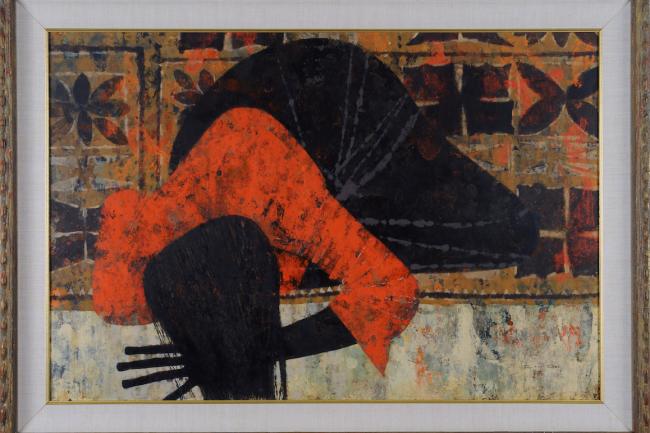By Aaliyah Butler
The Howard University Gallery of Art painting “Despondency” (c. 1961) by Charles McGee (1924-2021) is featured in the “Black Melancholia” exhibition in the CCS Bard Galleries at the Hessel Museum of Art from June 25 through October 16, 2022.
A well-known figure on the art scene in Detroit, McGee created a vast catalog of works from charcoal drawings and photography to avant-garde three-dimensional pieces incorporating various media. His works have both chronicled the Black experience and celebrated his lifelong love of nature.
“The Howard Gallery is pleased to be able to loan this work to an exhibition highlighting the work of Black artists through an innovative curatorial lens,” said Abby Eron, Ph.D., registrar for the Howard University Gallery of Art. “In ‘Despondency,’ McGee used the body’s language of pose and posture to convey a state of sorrow. His painting’s forms, with colors and patterns inspired by central and West African textiles, make for an impactful image. The gallery’s art loan program generates opportunities for programming and internships for Howard students at museums nationwide, including the Hessel.”
“Black Melancholia” expands and complicates the notion of melancholy in Western art history and cultures. Including new commissions as well as painting, sculpture, film, photography, works on paper, and sound, “Black Melancholia” pushes beyond the iconography of melancholia as an art historical and psychoanalytical concept to subvert highly racialized discourses in which notions of longing, despair, sadness and loss were reserved for white subjects. The exhibition aims to create a generative space for inspiration, solace and refuge through a presentation that blends new and recent works with pieces from the late 19th to mid-20th century.
“’Black Melancholia’ is an ambitious reconfiguring of a historic narrative directing attention to a well-worn term (melancholy) and reframing it through the artworks of a transnational and transgenerational group of artists,” said Tom Eccles, executive director of the Center for Curatorial Studies, Bard College, and founding director of the Hessel Museum of Art. “The result of extensive research and scholarship on the part of Nana Adusei-Poku, Ph.D., this large-scale and contentious exhibition reckons with the past and portrays a complex present and future for artists of the African Diaspora.”
In framing this expanded understanding of melancholia, the exhibition begins with a historic survey of works by Black artists, many on loan from historically Black colleges and universities, including Howard, Spelman and Clark Atlanta, which represent some of the primary institutions collecting and exhibiting these works at the time of their creation. Foundational to the exhibition is the inclusion of artist Augusta Savage (1892–1962), whose work has largely been lost due to lack of preservation and stewardship. Her sculpture “Realization” (1936), which is presented via black and white photographs within the exhibition’s opening room, depicts a nude Black woman and man curled up next to her, representing the moment of realization of freedom of two previously enslaved individuals. Savage’s choice to show two figures establishes a counternarrative to the socially isolated individualistic pain of the white male subject, as embodied in Rodin’s “The Thinker” (conceived in 1880).





